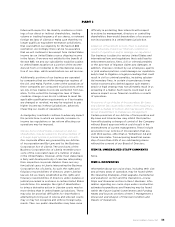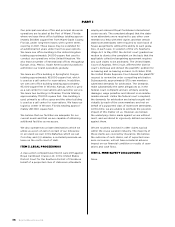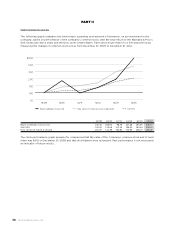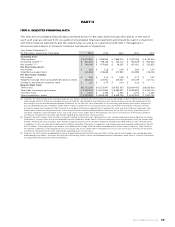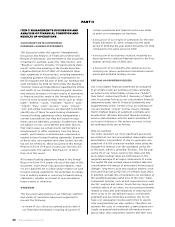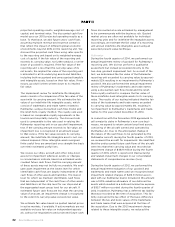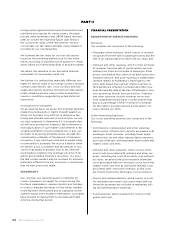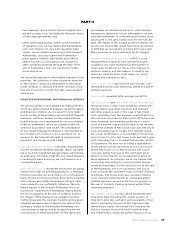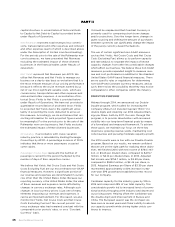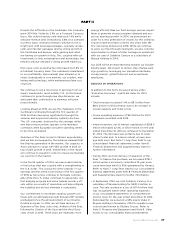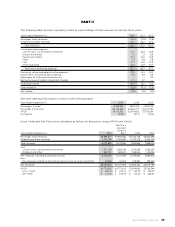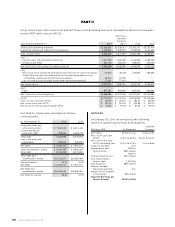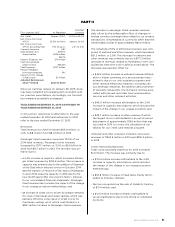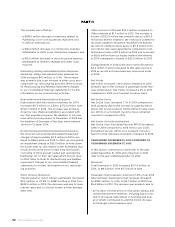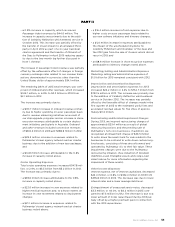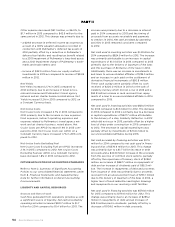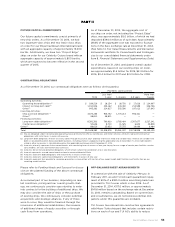Royal Caribbean Cruise Lines 2014 Annual Report Download - page 46
Download and view the complete annual report
Please find page 46 of the 2014 Royal Caribbean Cruise Lines annual report below. You can navigate through the pages in the report by either clicking on the pages listed below, or by using the keyword search tool below to find specific information within the annual report.
Royal Caribbean Cruises Ltd. 45
• Fuel expenses, which include fuel and related deliv-
ery and storage costs, including the financial impact
of fuel swap agreements; and
• Other operating expenses, which consist primarily
of operating costs such as repairs and maintenance,
port costs that do not vary with passenger head
counts, vessel related insurance and entertainment.
Additionally, costs associated with Pullmantur’s
travel agency network, land-based tours and air
charter business to third parties are included in
other operating expenses through the date of the
sale of Pullmantur’s non-core businesses further
discussed below.
We do not allocate payroll and related expenses, food
expenses, fuel expenses or other operating expenses
to the expense categories attributable to passenger
ticket revenues or onboard and other revenues since
they are incurred to provide the total cruise vacation
experience.
SELECTED OPERATIONAL AND FINANCIAL METRICS
We utilize a variety of operational and financial metrics
which are defined below to evaluate our performance
and financial condition. As discussed in more detail
herein, certain of these metrics are non-GAAP financial
measures, which we believe provide useful informa-
tion to investors as a supplement to our consolidated
financial statements, which are prepared and pre-
sented in accordance with GAAP. The presentation
of non-GAAP financial information is not intended to
be considered in isolation or as a substitute for, or
superior to, the financial information prepared and
presented in accordance with GAAP.
Adjusted Earnings per Share represents Adjusted Net
Income divided by weighted average shares outstand-
ing or by diluted weighted average shares outstanding,
as applicable. We believe that this non-GAAP measure
is meaningful when assessing our performance on a
comparative basis.
Adjusted Net Income represents net income excluding
certain items that we believe adjusting for is meaning-
ful when assessing our performance on a comparative
basis. For the periods presented, these items included
restructuring and related impairment charges, other
costs related to our profitability initiatives, the esti-
mated impact of the divested Pullmantur non-core
businesses, impairment of Pullmantur related assets,
the loss recognized on the sale of Celebrity Century,
the impact of the change in our voyage proration
methodology and the reversal of a deferred tax asset
valuation allowance due to Spanish tax reform. The
estimated impact of the divested Pullmantur non-
core businesses was arrived at by adjusting the net
income (loss) of these businesses for the ownership
percentage we retained as well as for intercompany
transactions that are no longer eliminated in our con-
solidated statements of comprehensive income (loss)
subsequent to the sales transaction. For the full year
2014, the impact of the voyage proration change rep-
resents net income that would have been recognized
in 2013 had we recognized revenues and cruise oper-
ating expenses on a pro-rata basis for all voyages.
Available Passenger Cruise Days (“APCD”) is our
measurement of capacity and represents double
occupancy per cabin multiplied by the number of
cruise days for the period. We use this measure to
perform capacity and rate analysis to identify our
main non-capacity drivers that cause our cruise
revenue and expenses to vary.
Gross Cruise Costs represent the sum of total cruise
operating expenses plus marketing, selling and admin-
istrative expenses.
Gross Yields represent total revenues per APCD.
Net Cruise Costs and Net Cruise Costs Excluding Fuel
represent Gross Cruise Costs excluding commissions,
transportation and other expenses and onboard
and other expenses and, in the case of Net Cruise
Costs Excluding Fuel, fuel expenses (each of which is
described above under the Description of Certain Line
Items heading). In measuring our ability to control
costs in a manner that positively impacts net income,
we believe changes in Net Cruise Costs and Net Cruise
Costs Excluding Fuel to be the most relevant indica-
tors of our performance. A reconciliation of historical
Gross Cruise Costs to Net Cruise Costs and Net Cruise
Costs Excluding Fuel is provided below under Results
of Operations. We have not provided a quantitative
reconciliation of projected Gross Cruise Costs to pro-
jected Net Cruise Costs and projected Net Cruise
Costs Excluding Fuel due to the significant uncer-
tainty in projecting the costs deducted to arrive at
these measures. Accordingly, we do not believe that
reconciling information for such projected figures
would be meaningful. For the periods prior to the sale
of the Pullmantur non-core businesses, Net Cruise
Costs excludes the estimated impact of these divested
businesses. Net Cruise Costs also excludes initiative
costs reported within Marketing, selling and admin-
istrative expenses, as well as the loss recognized on
the sale of Celebrity Century included within Other
operating expenses.
Net Debt-to-Capital is a ratio which represents total
long-term debt, including the current portion of
long-term debt, less cash and cash equivalents (“Net
Debt”) divided by the sum of Net Debt and total
shareholders’ equity. We believe Net Debt and Net
Debt-to-Capital, along with total long-term debt
and shareholders’ equity are useful measures of our
PART II


